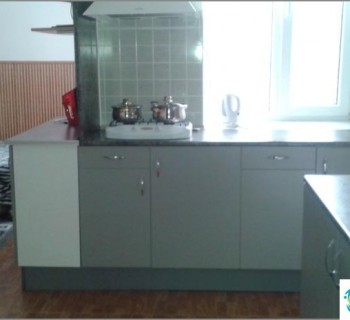Last time I talked about food in Thailand in Thai cafes and in Thai supermarkets. The story will be incomplete if you bypass the markets for vegetables, fruits and other foods. There are a lot of interesting things sold in the markets, and for sure you will want to try everything. At least that's why it's worth going there. You will also get the opportunity to touch another side of Thai life, an integral part, so to speak..
Thailand is one continuous food market, it is sold everywhere. Imagine how convenient it is when on the street there is an opportunity to eat cut fruit for a symbolic price, or when you have prepared Pad Thai. This is especially true of crowded places - near shops, on popular streets, beaches, during the holidays. By the way, the latter is a direct tradition of Thailand, well, there can be no good celebration without tons of varied food..
The content of the article
Markets in Thailand
Market opening hours
Typically markets in Thailand are daily, morning or evening, or on some days of the week. Moreover, in one place the market may be on Friday evenings, and in another - on Monday mornings. The place where the market is usually held can look like a concreted area with rows of trays under the roof, or it can be an ordinary dusty wasteland at non-market times. You need to find out the opening hours of the market in a specific area / resort from the locals, they will tell you exactly what is where and when.
There is also a type of markets called night market, which translates as «night». But in fact, this is exactly the evening, from sunset (17-18 hours) until the evening (20-21 hours). Typically, this is a blended market selling clothes, trinkets and a variety of ready-to-eat foods, from the traditional Pad Thai to cooked chips and fruit shakes..
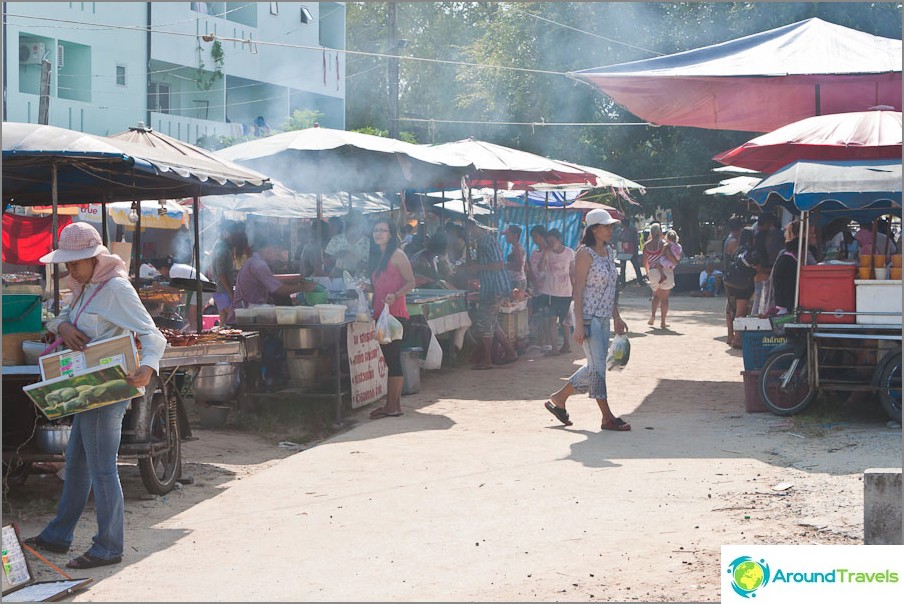
Open-air market in Phuket
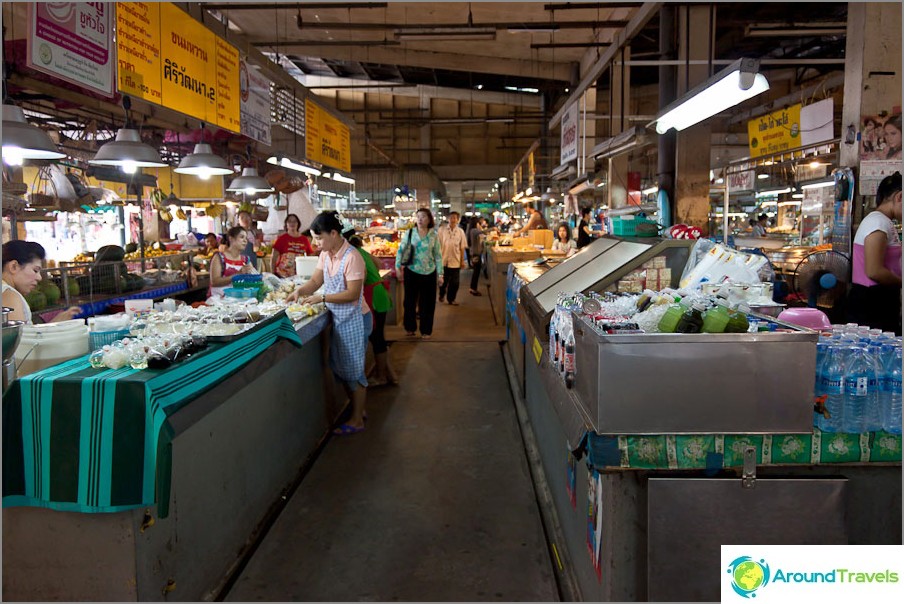
Indoor market in Chiang Mai
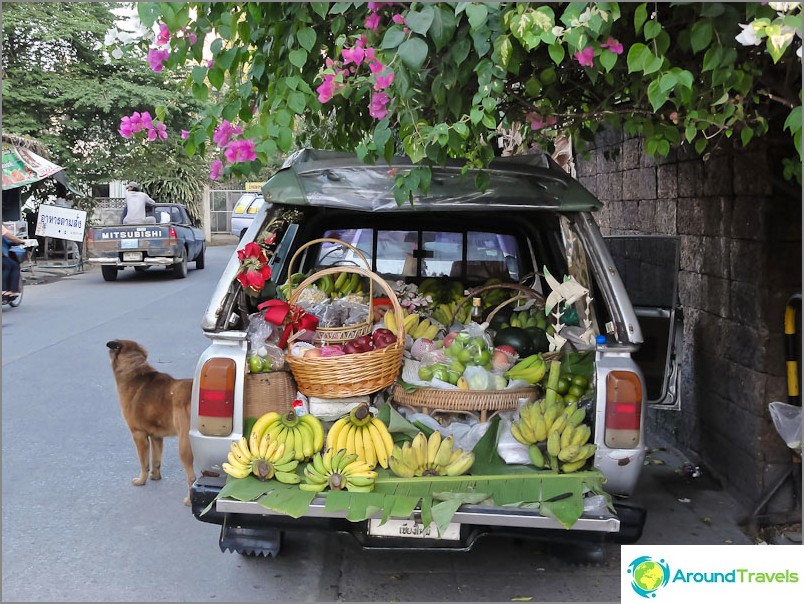
Mobile mini-market
Food prices
Prices in Thai markets are not always very different from those in large supermarkets such as Tesco Lotus and Big C. When the season begins for a local fruit, it can be bought in the market for almost a penny. This includes lychees, longans, rambutans, mangoes, durians, pineapples and other Thai fruits. Bananas, coconuts, papayas, watermelons can be bought almost all year round.
The cost of some products in the markets:
- Watermelon - from 20 baht / kg.
- Mini bananas from 10 baht for a small branch.
- Mango - from 10-25 baht / kg for green and from 70 baht / kg for large yellow mangoes, it is possible to buy yellow ones at 35-45 baht / kg, if in season they are small and slightly overripe.
- Coconut - 15-40 baht a piece. On the market, coconuts are often sold unprocessed, whole. On request, they can open a nut with a large cleaver right in front of you..
- Thai sushi - 5-10 baht per piece. The taste is not very impressive, but for a change you can try.
- Thai sweets, donuts, cakes, pies - from 5-15 baht per piece.
- Already cooked fish - from 25 baht for two small fish. There is a big fish cooked in salt, around 100 baht apiece.
- Pancakes with fillings (usually a banana with an egg, but sometimes a mango, etc., if desired, they can be poured with condensed milk, chocolate or jam) - 35-40 baht apiece. Just as there is shawarma in Moscow and shawarma in St. Petersburg, these pancakes are called differently in different regions. Somewhere this «banana pancake», somewhere «rotee». At the very bottom, watch the video of how they are prepared..
- Fried rice, noodles, packaged salads, broths - from 25 baht per serving, usually 35-45 baht.
- Sliced portions of fruit in a tray - 25-40 baht.
- Durian - from 90 baht / kg.
- Rambutans - from 20 baht / kg.
- Mangosteen - from 30 baht / kg.
- Papaya - from 20 baht / kg.
- Pineapple - from 30 baht apiece.
- Tomatoes, cucumbers, etc. vegetables - from 20 baht / kg.
- Mussels - from 45 baht / kg.
- Large shrimps - from 150 baht / kg.
- Snails, scallops, etc. - from 120 baht / kg.
- Tiger prawns - from 350 baht / kg.
- Ready-made pork skewers on skewers, balls, sausages - around 30 baht apiece.
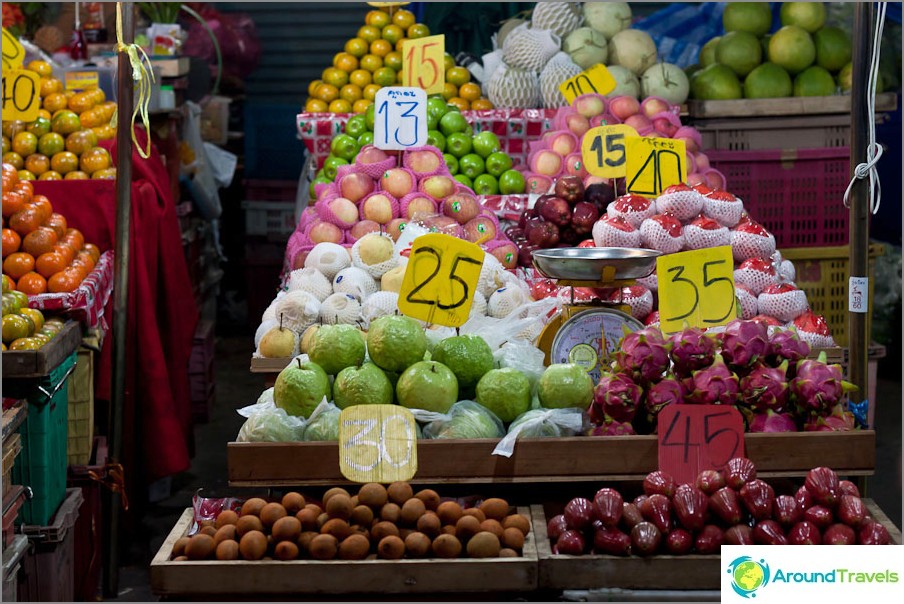
Fruit prices in Thailand
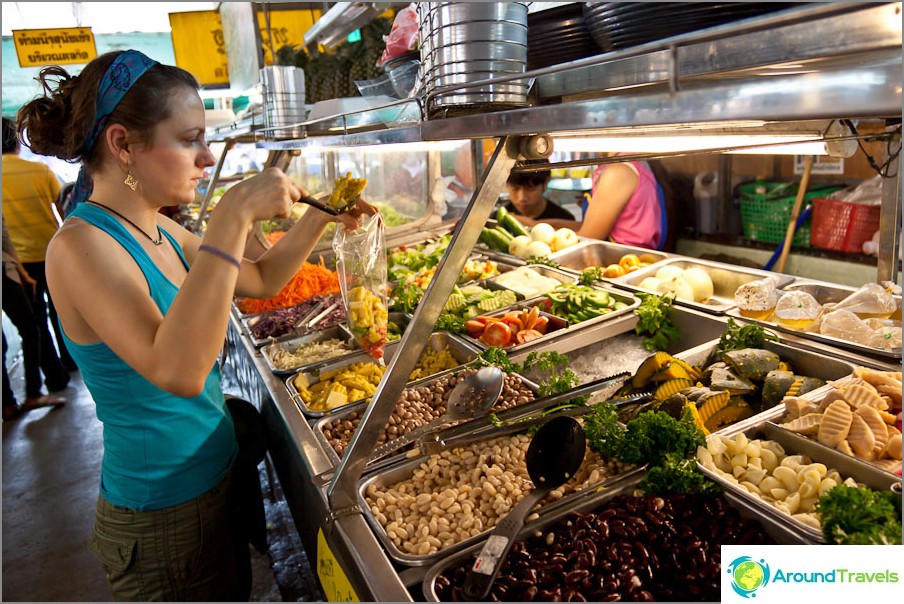
Food by weight, 100 gr - 10 baht
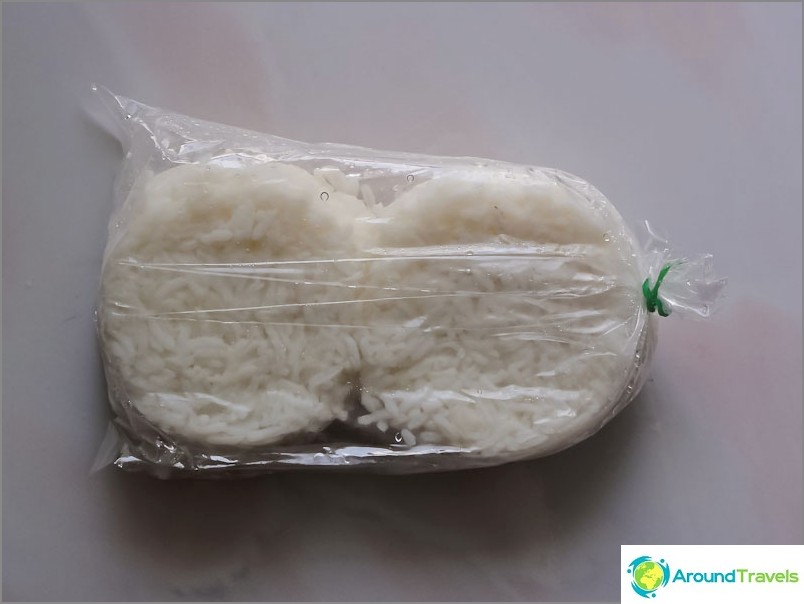
Two rice washers for 20 baht
Clothes prices
Prices for clothing and footwear in the markets start almost from zero. The simplest T-shirt-cap-pants can be bought literally for 50 baht. Cotton children's dresses - from 30 baht, rubber children's slippers - from 30. Of course, these are all the cheapest and of the lowest quality, «for a day». But if this is not Chinese game and synthetics, the option «for beach and village» there you can buy. Thais are very fond of the reception «buy 3, get a discount». For example, a children's sundress for 50, and three for 100. A skirt for 80, and three for 200. Women's blouses in the markets can be bought from 100 baht, jeans - from 300, shorts - from 200. In places where clothes are sold , designed for foreigners, prices are of course more expensive. Usually this «ethnic» colorful bags, dresses, skirts, blouses. A la handmade. In this case, a dress-sundress will be more likely for 400-500 baht and above, blouses and tops - from 150 baht, beach slates - around 100 baht, children's clothes - from 200 baht.
What can you buy in the Thai market
Markets in Thailand are divided into purely fish (seafood market), fruit and vegetable and mixed markets, where they sell not only food and ready-made food, but also clothes. We can say that there are markets where only clothes and other accessories are sold, but they will still sell food there too. Yes, there may not be fruits, vegetables and meat-fish (or there will simply be a small selection), but in any case it means ready-made food will be sold.
Tourist destinations also offer exemplary markets for foreigners. Fruits there are pretty, perfect, mostly those that are popular with tourists. They also often sell plastic baskets for transporting fruits (especially to be carried on the plane in hand luggage). Prices in such places are higher than in regular markets. «for the people».
clothing
In addition to products in Thai markets, clothes, shoes, various household goods, etc. are also sold. In the markets for local residents, clothes are sold the simplest, cheapest, in most cases, synthetic Chinese. These are T-shirts, shorts, dresses, baseball caps, etc. From shoes - rubber flip flops, fake crocs, sneakers. There are also clothes for children. There are many Muslims in the southern regions of Thailand, therefore, specific clothing for Muslim women is found in the markets - long-sleeved dresses, headscarves.
If it is not synthetics, but cotton, then something can be bought in the markets, but rather as a beach option or a souvenir. Because the quality is not very good, and there is nowhere to try on clothes on the market. But if suddenly you like funny «authentic» a skirt or a simple children's cotton sarafan or a men's shirt with short sleeves - it is quite possible to buy, everything is very inexpensive in Thai markets, prices start literally from 25 baht.
In places where tourists congregate, at every step you come across small markets with specific goods for vacationers: swimwear, children's inflatable rings and oversleeves, swimming pools, all sorts of plastic buckets and paddles for children, shorts, T-shirts, T-shirts, baseball caps, dresses. These are clothes for foreigners, locals do not wear such clothes. It is of slightly better quality than in quite village markets. But all the same, it is more likely designed for a spontaneous purchase on the wave of vacation enthusiasm. Although it must be admitted that it is more pleasant to buy colorful sundresses and fluffy skirts in Thailand at prices than in Russia.
Fruits
In Thailand, I became practically an idolater of mango and papaya. As it turned out, not everyone likes papaya (unlike mango). I didn’t taste it right away either. But then she became a regular at my breakfast.
And of course, I can't help but say a few words about mango. Its taste can be compared to good sex, as it never gets bored and every time it tastes as strong as if it were the first time. Imagine that every time you eat a tomato, you will exclaim - «oh god, how delicious!» It's difficult to imagine? Yes, tomatoes are not the same today, but with mango it will be just like that.
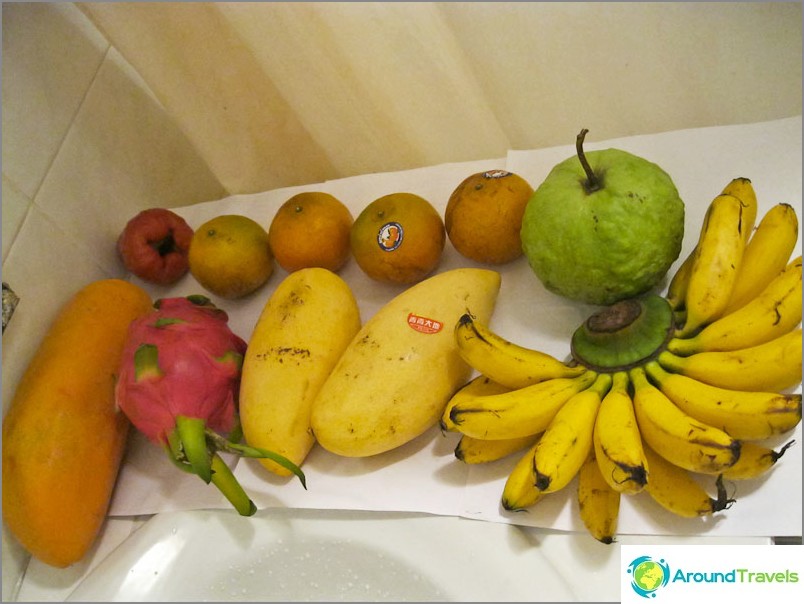
Tropical fruits of thailand
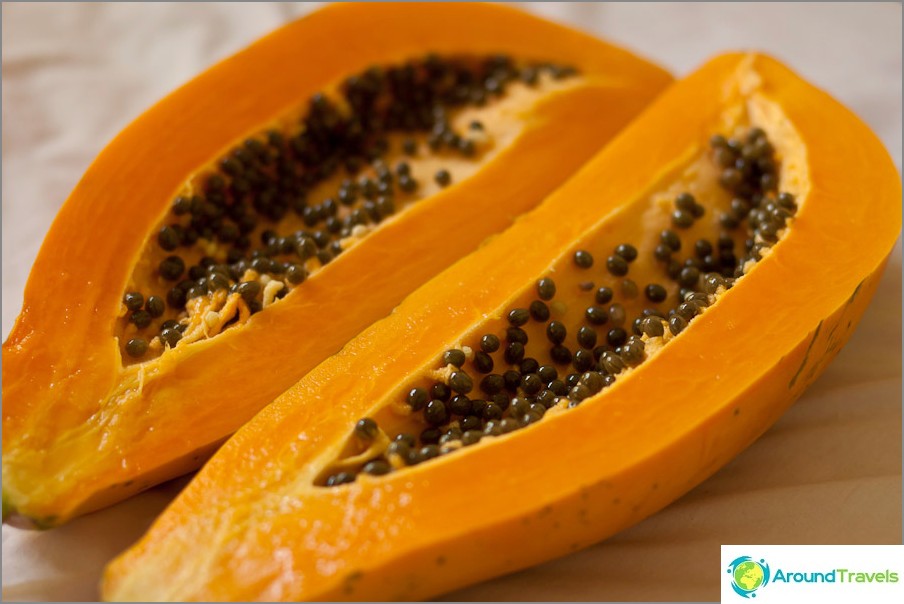
Papaya or mango is the best breakfast in the world
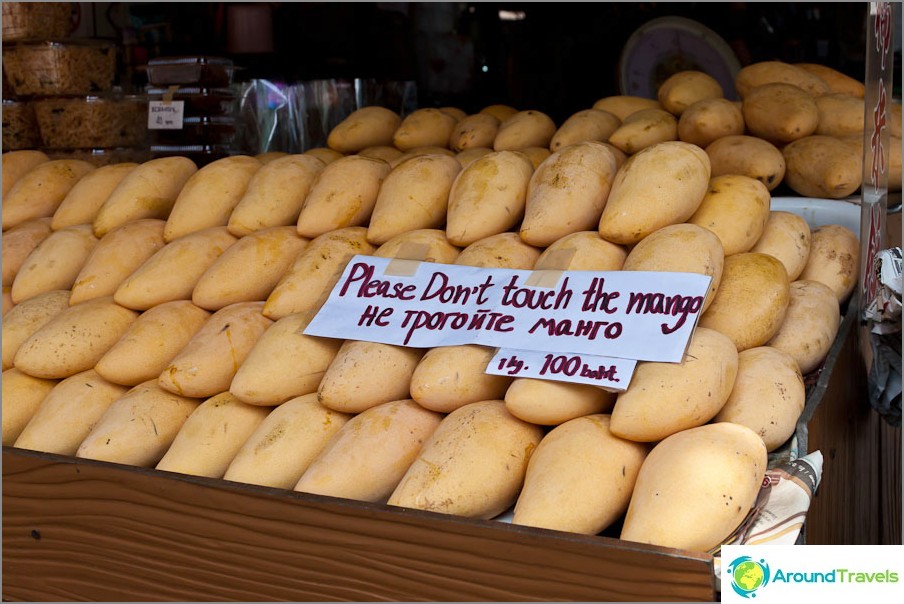
In Pattaya, the market even writes in Russian
Durians are another «iconic» thai fruit. He is either adored or hated. There are legends about it, after which not everyone dares to try it. Durians are even honored to be featured in official rules and signs in public places - they cannot be carried on airplanes, and some hotels do not allow them to be carried into rooms. In general, this is a very specific Thai fruit fanned with legends. Durian fruits are very large, green in color, with sharp thorns, and inside the tender flesh is slightly yellow. Since it is very difficult for a beginner to carve durian, their pulp is often sold in separate pieces, in a tray under a plastic wrap. Inexpensive durians are only in season, and so generally they cannot be called a cheap fruit. I personally like the taste of durian. I even made a separate post about him with a video - What does durian smell like?.
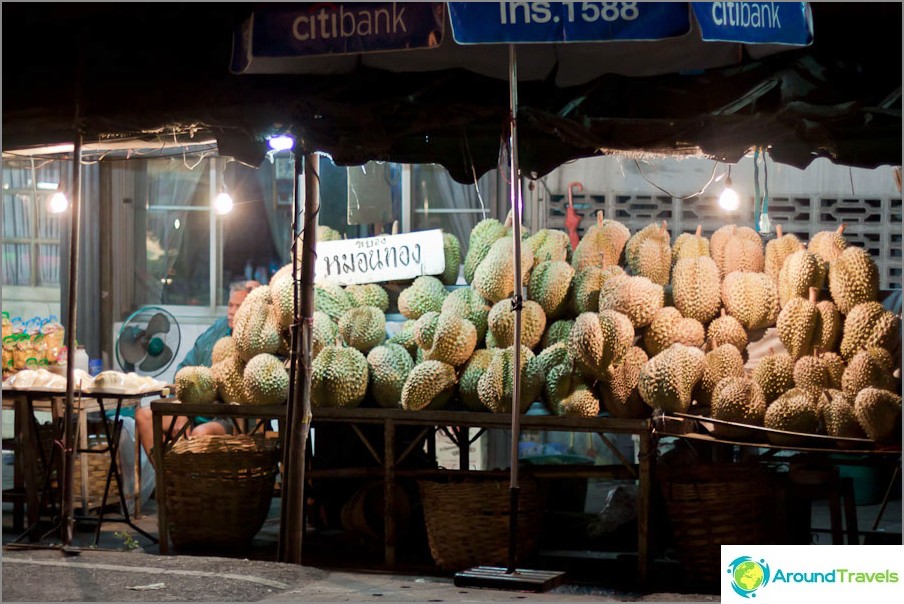
A counter with my favorite durians
When the season of some kind of fruit begins in Thailand, they are sold in the markets literally in wagons - they pile large mountains into pickup trucks, carry them along the streets, sell them from stalls on the sidelines. Basically, these are inexpensive purely Asian fruits: longan, rambutan, lychee, tamarind, herring, mangosteen, guava, sapolilla, rose apple, sugar apple, carom, jackfruit. Yes, there are a lot of fruits in Thailand. All of the above is quite specific, but it's interesting to try it. From what foreigners usually like, coconuts, the already mentioned mango, passion fruit, pomelo, dragon fruit, pineapple (in Thailand, they are much tastier than those that we sell), tangerines (Thai tangerines with green peel). Of the fruits we are used to in the markets, they sell watermelons (and there is a variety of oblong and yellow inside, but they taste the same), small bananas (also very tasty, much better than ours), apples and Chinese pears.
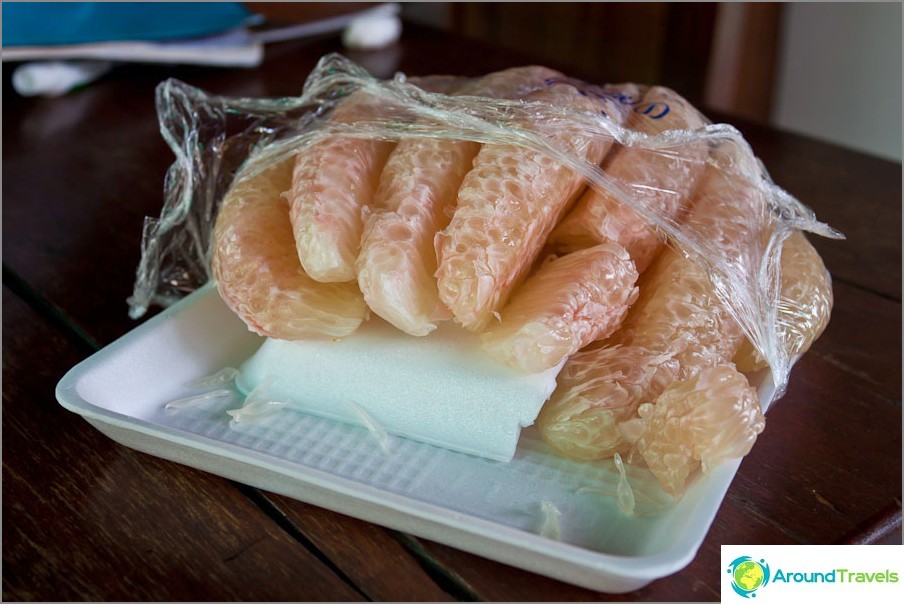
Sometimes Thais use styrofoam to make the fruit appear larger.
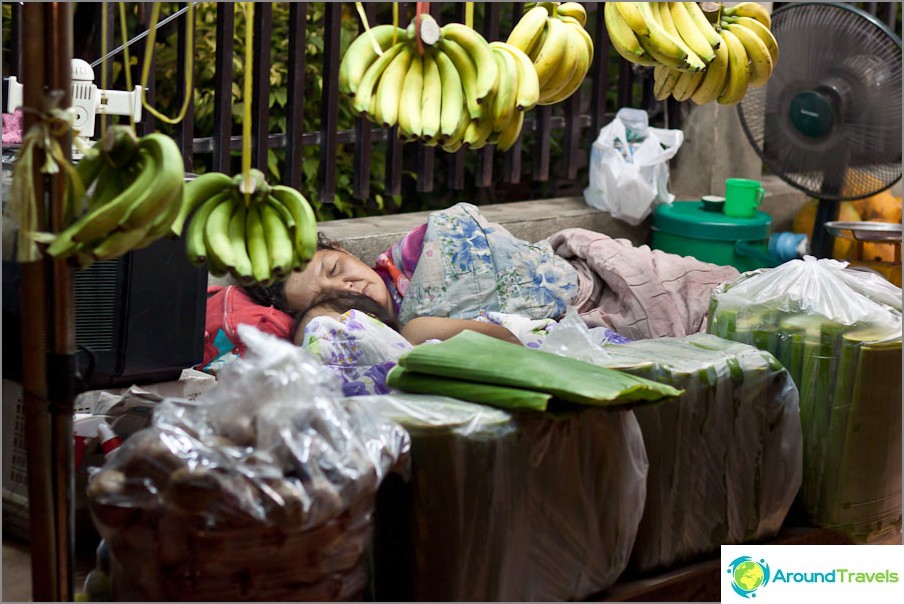
While there are no clients, you can sleep
Vegetables
If we talk about vegetables, then there are not very many types of them in Thailand and they are cheap. In addition to the usual potatoes, carrots and tomatoes, cucumbers, a huge amount of all kinds of greens and lettuce leaves are sold in the markets. From the usual coriander and parsley to bunches of unsightly-looking grass. From not very familiar to us and loved by Thais, we can name asparagus sprouts, green eggplants and Thai zucchini, green beans. And I personally really liked the herb Morning Glory and Kale, they can be added to a salad or omelet.
In addition to fresh vegetables and fruits, a large number of all kinds of seasonings are sold in the markets in the form of powder, paste or whole dried fruits..
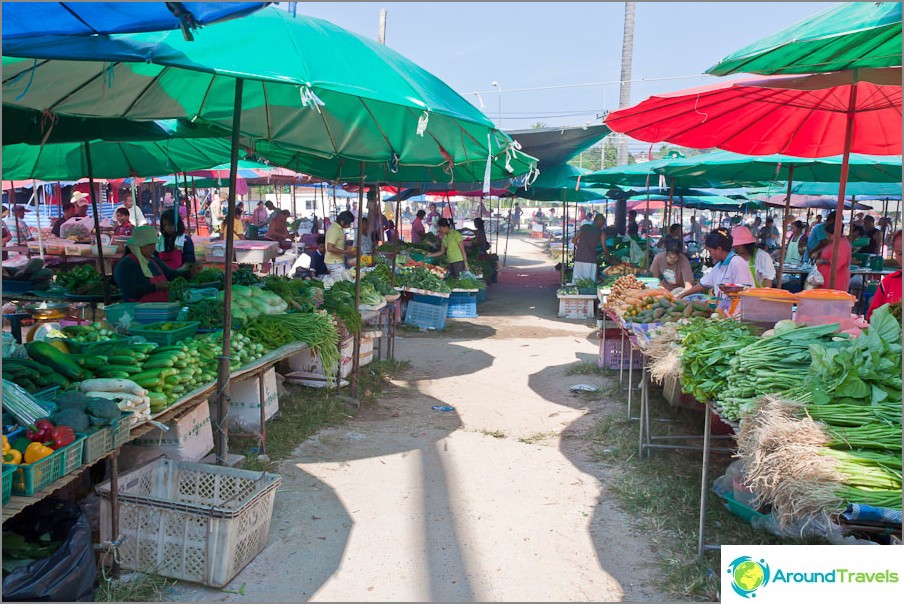
Thai vegetables and herbs on the market
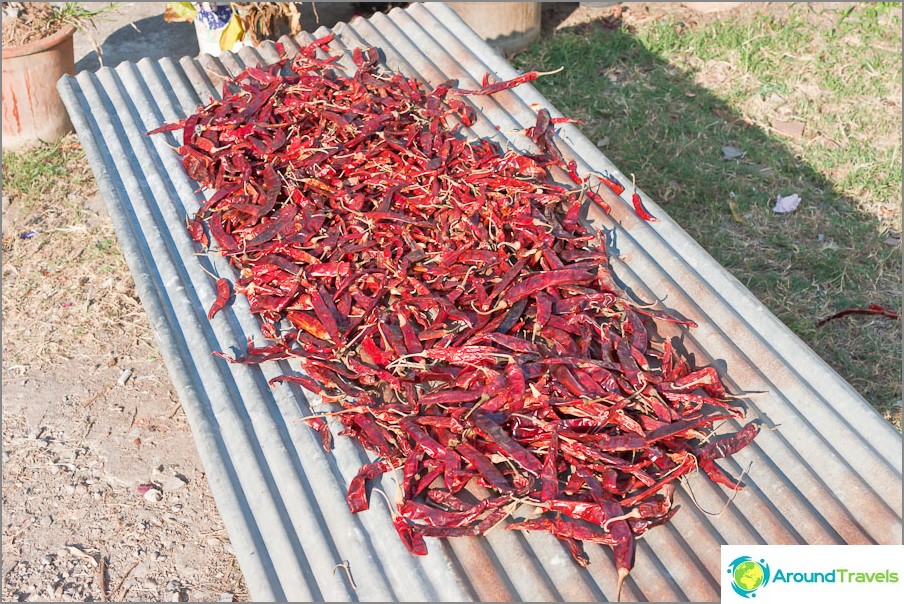
The main ingredient in Thai food
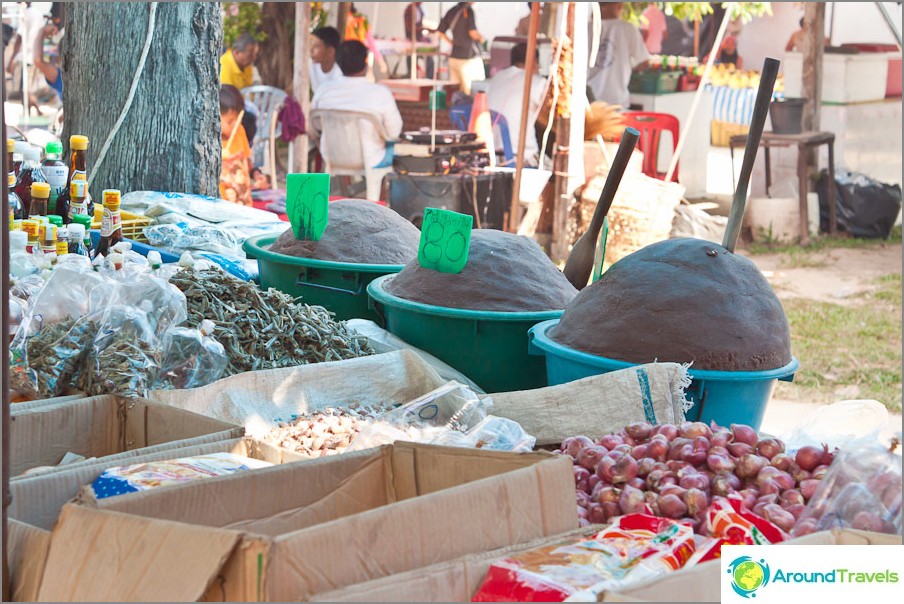
Strange Easter cakes in buckets
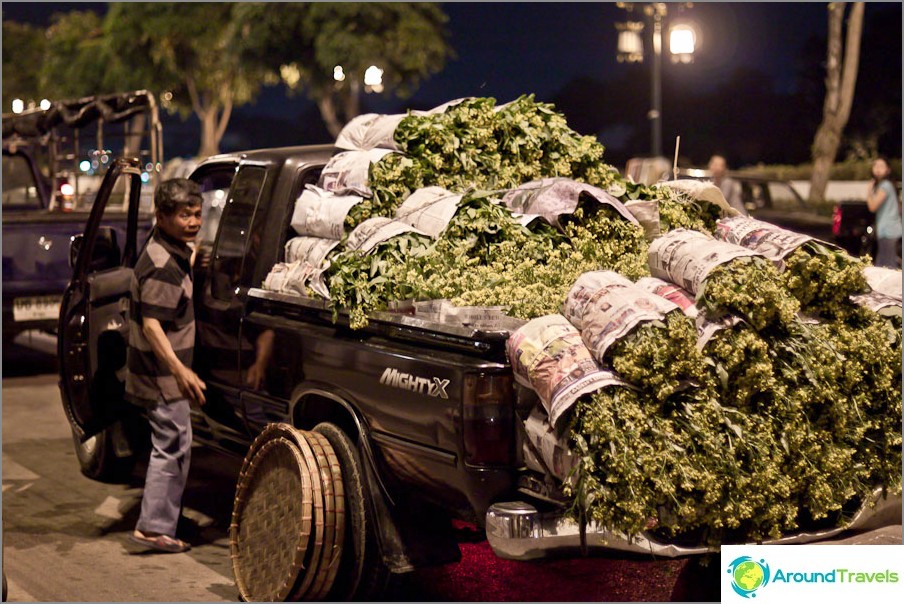
Thai farmers brought some greens
Meat and fish
In Thailand, it is quite common and in any area to find a Seafood market or seafood markets. There, in addition to the actual fish, you can find crabs, shrimps, various varieties of shells and mussels, snails, swordtails and other marine exoticism. It's all worth it in different ways. From inexpensive mussels in shells to very expensive (especially with the current ruble exchange rate) tiger prawns at 450 baht per kg.
Fish and seafood are sold fresh, usually a morning catch. Put everything on ice. Of course, there is a smell in the fish rows and flies also fly, but seafood does not stay on the shelves for a long time, everything is quickly disassembled. So it happens by noon there is nothing left.
Raw meat in the markets in Thailand is also sold, but given the climate (and flies flying over the meat), not all foreigners decide to buy it in the markets.
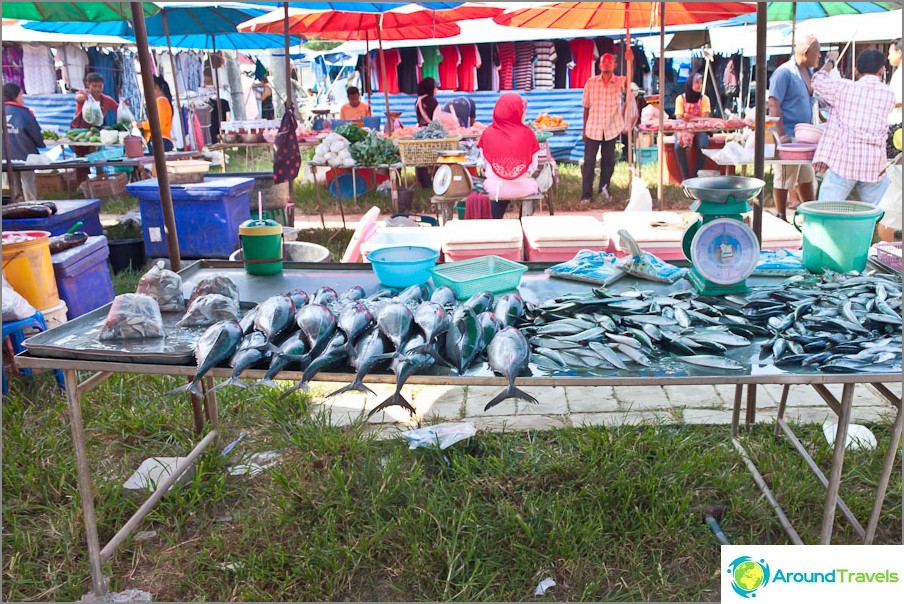
Fish and seafood usually lie on ice
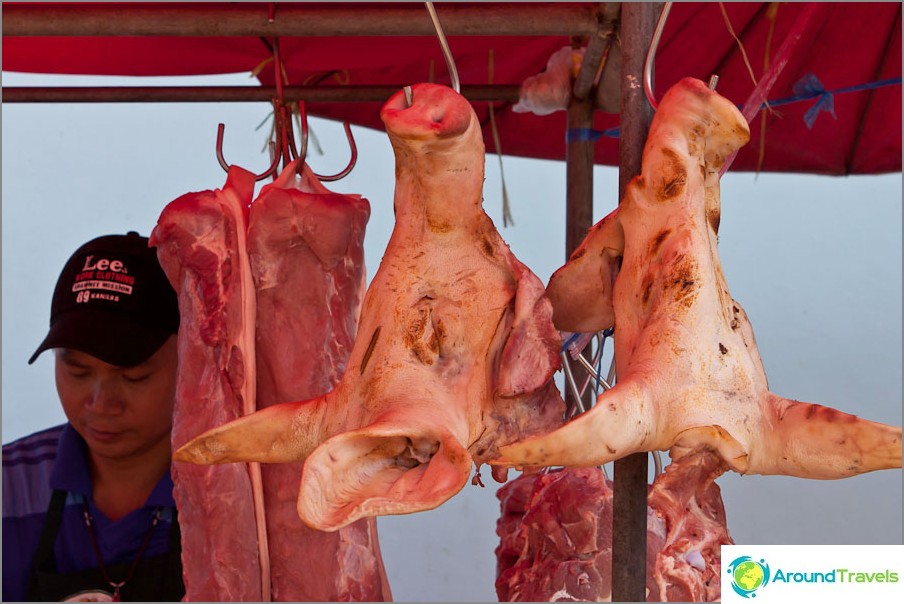
Fresh pig heads, almost grunt
Ready meals
One of the main differences between Thai markets and ours is that ready-made food is sold in large quantities there, which can be eaten immediately on the spot or taken home in a tray or bag. I always eat on the street, it turns out very tasty and inexpensive.
The most common dish in the market is Pad Thai rice noodles. Although personally I do not really like it in the markets, because it is not always a real Pad Thai, but rather just fried noodles. I also often buy vegetable spring rolls with hot and sweet sauce or shrimp in batter. And to wash down the whole thing is excellent with a fruit shake made from mango or pineapple. Many people also like kebabs on skewers made from chicken or pork, but squids are quite tough, for an amateur.
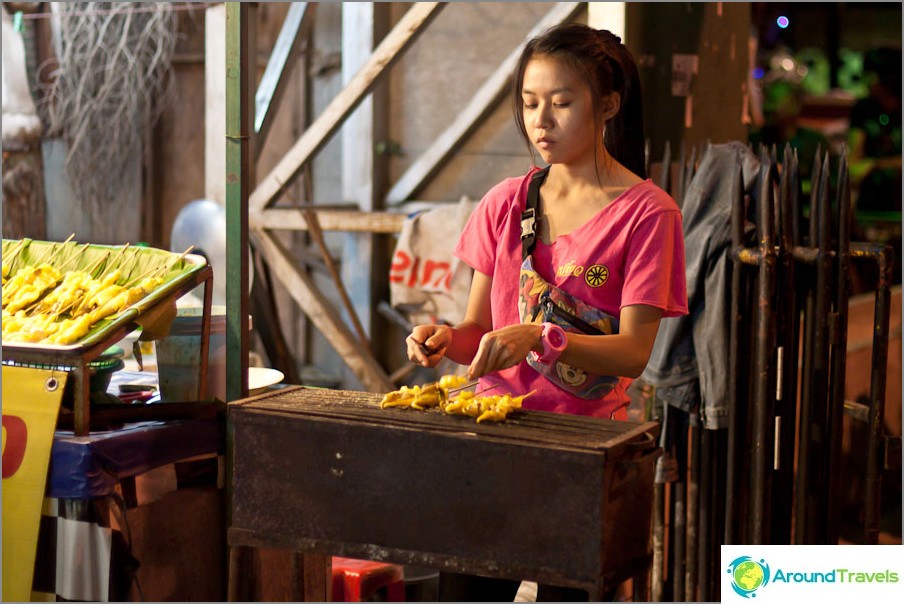
Fried squid on wooden skewers
In general, the markets sell mainly fried and boiled, in broth, sauce and very spicy. Dried meat and fish, all kinds of noodles - both in broth and fried, rice (where without it), Thai salad of green papaya som-tam, stewed vegetables, all kinds of fried pies, donuts and cakes. It is also common to see trays with Thai rolls and sushi. Including with green caviar. They don't taste good, but for a change you can try.
There are also trays in the markets where you can make a salad from the ingredients. And it happens that such salads are sold ready-made, in inflated bags. Often in the markets you can buy stewed duck in pieces, with rice, in the form of a second course or in broth. Rotee or banana pankace are always popular among tourists - pancakes stuffed with banana and condensed milk. In general, the variety of Thai food can be described endlessly, but it is better to come to the market and see all this (touch, smell, taste) yourself.
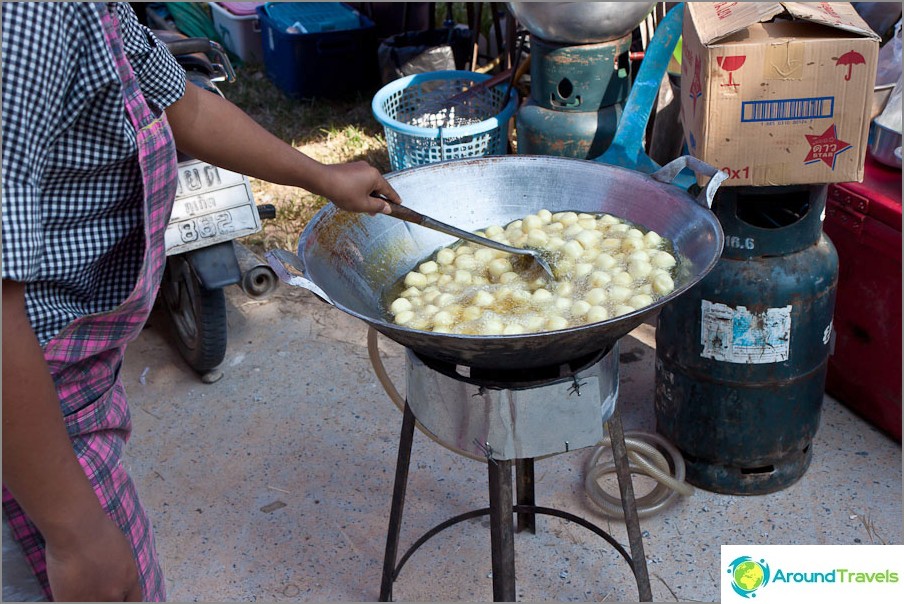
Bread balls in butter
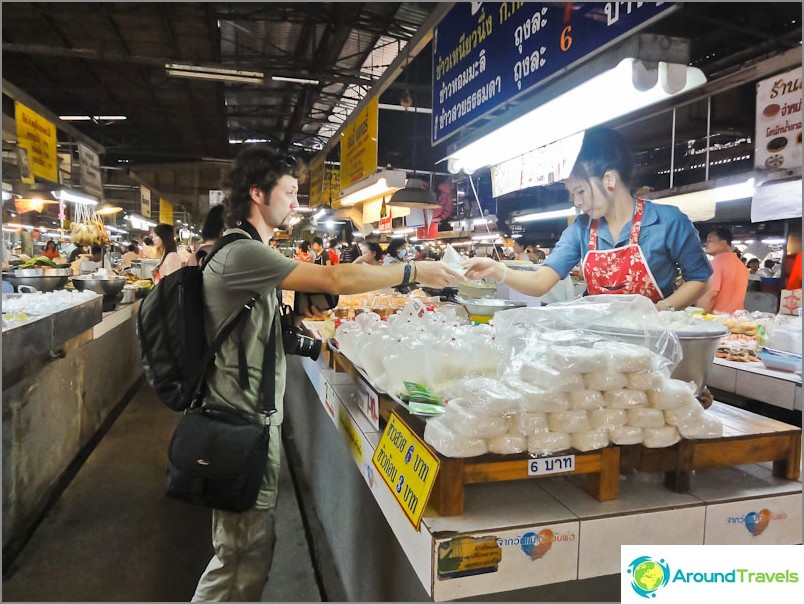
I buy ready-made rice in the market

Pile of chips
Exotic food
It is believed that in Asia they often eat something that is difficult to imagine for us Europeans. But for everything wintering in Thailand from exotic, I saw only fried insects and live frogs, and not in every market. But when I was in China and went to their market, there, yes, a lot of all kinds of stuff that are scary to look at.
So in Thailand you will not find something very unusual, especially when it comes to resorts and markets in them. Still, everything there is pretty much tailored for tourists. It is clear that the Russian people and mangoes are exotic, but still they are not sea worms..
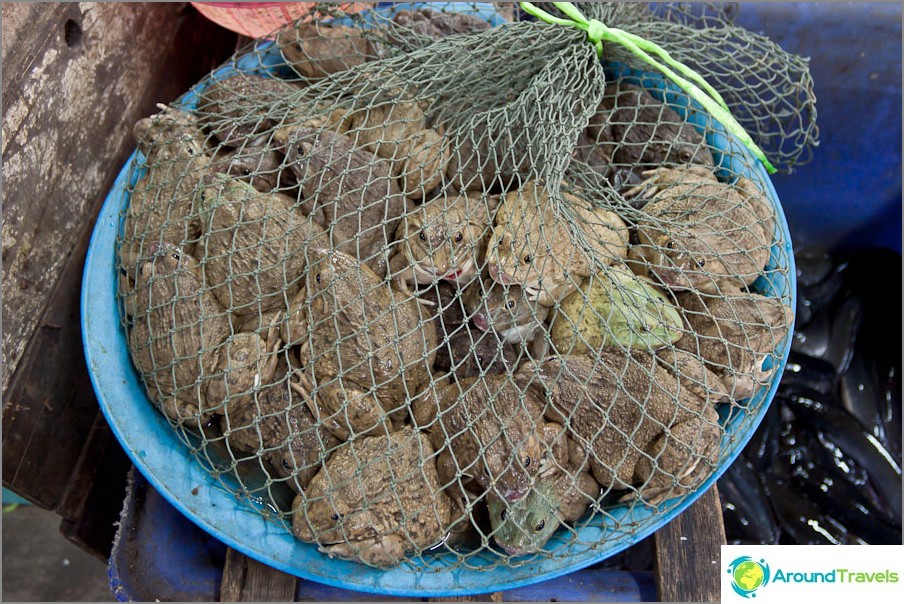
I didn't buy frogs in the market
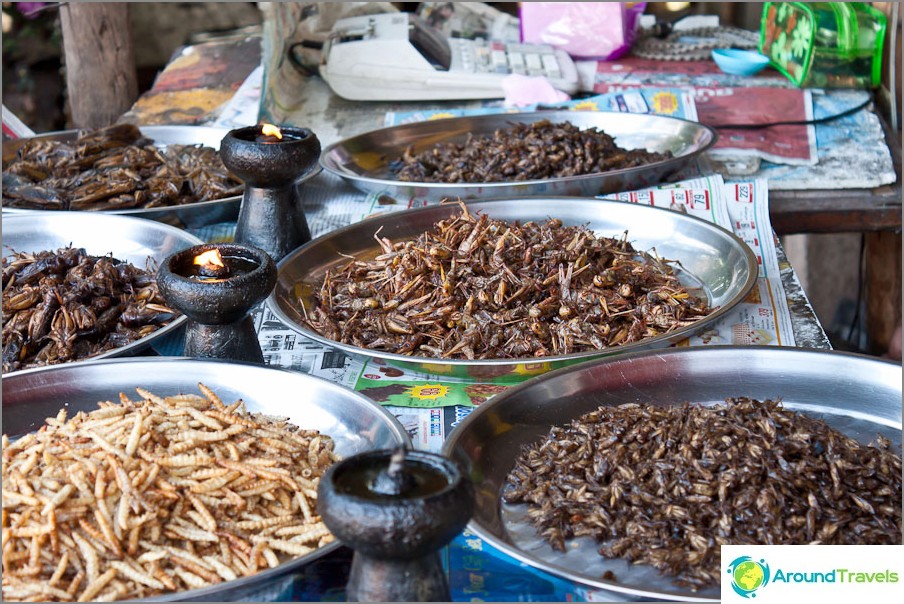
Grasshoppers resemble regular chips
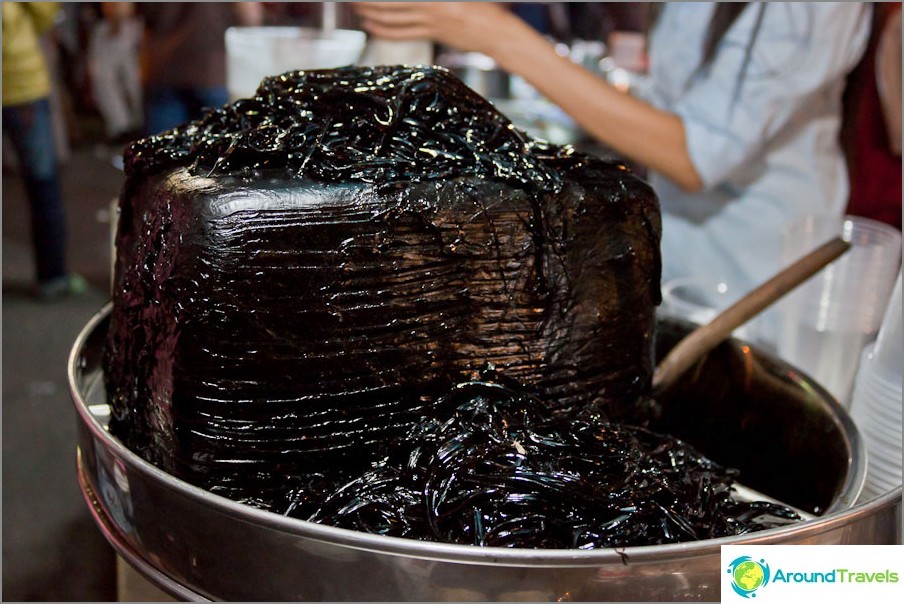
Black stuff that is added to cocktails tastes so-so
Video
AND «for a snack» - a video about how I eat grasshoppers and the process of making Thai pancakes.


